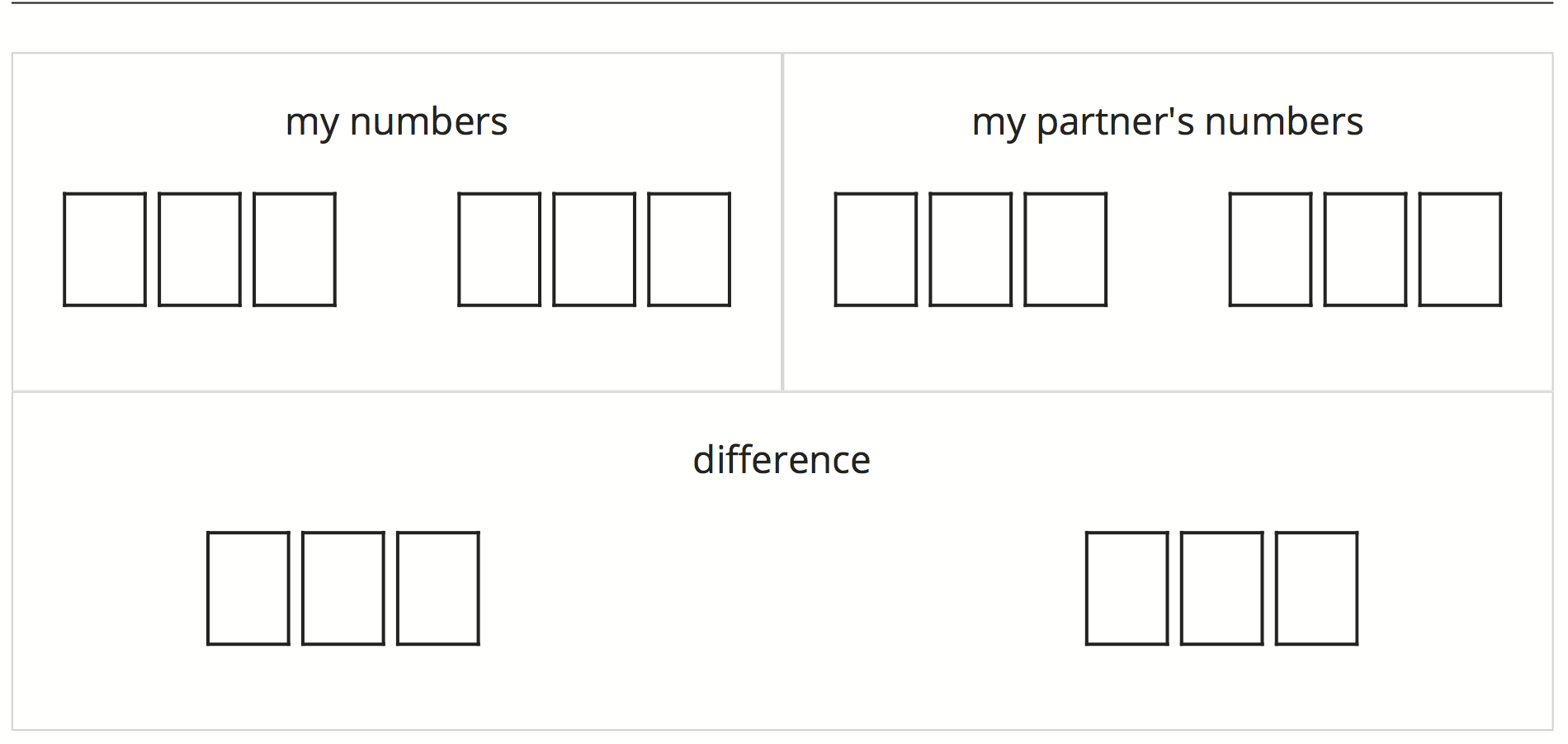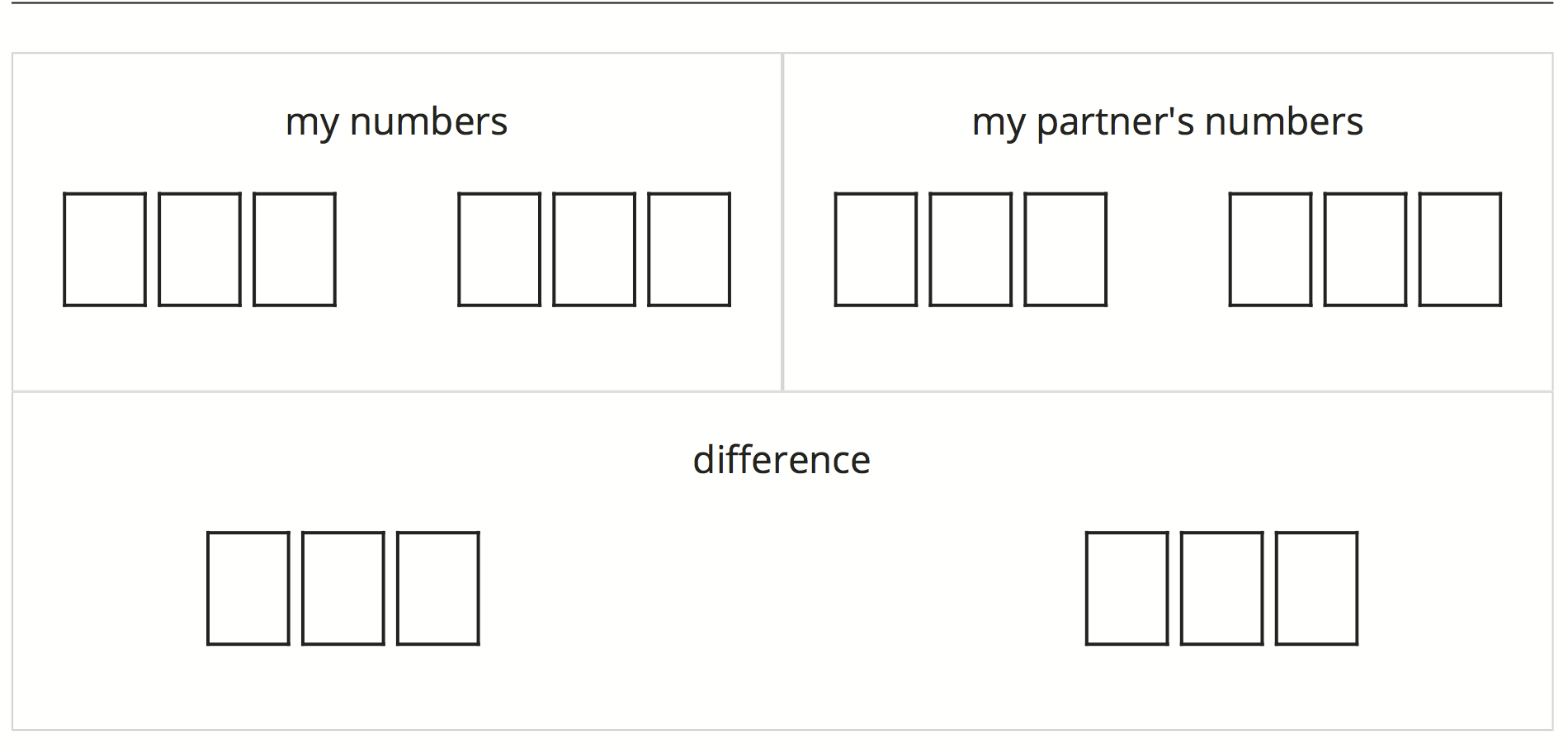Lesson 12
Subtract Strategically
Warm-up: Number Talk: Threes (10 minutes)
Narrative
The purpose of this Number Talk is to elicit strategies students have for finding products of single-digit factors. These reasoning strategies help students develop fluency and will be helpful later in this unit when students solve two-step word problems.
When students use strategies based on the properties of multiplication to find unknown products, they look for and make use of structure (MP7). Students may reverse the order of the factors to create a multiplication fact they know. Students may think about “one more group” as they move from the first expression to the second expression (or the third to the fourth). Also, students may say that they “just know” the product. All of these responses are acceptable because students will be in different stages as they progress toward fluency.
Launch
- Display one expression.
- “Give me a signal when you have an answer and can explain how you got it.”
- 1 minute: quiet think time
Activity
- Record answers and strategy.
- Keep expressions and work displayed.
- Repeat with each expression.
Student Facing
Find the value of each expression mentally.
- \(2 \times 6\)
- \(3 \times 6\)
- \(2 \times 7\)
- \(3 \times 7\)
Student Response
For access, consult one of our IM Certified Partners.
Activity Synthesis
- “How did thinking about products of 2 help you find products of 3?” (I could think about 2 groups, then add one more group. I could think about 2 in each group, then one more in each group.)
- Consider asking:
- “Who can restate _____’s reasoning in a different way?”
- “Did anyone have the same strategy but would explain it differently?”
- “Did anyone approach the problem in a different way?”
- “Does anyone want to add on to _____’s strategy?”
Activity 1: How Would You Subtract? (20 minutes)
Narrative
The purpose of this activity is for students to choose a strategy or algorithm to subtract within 1,000. Students should attend to the details of numbers in the problems that could indicate whether a particular strategy or algorithm is most useful. The important thing is that students choose an algorithm or another strategy that they can use efficiently and accurately for the given problem. As students choose strategies to find the values of each expression, they look for common structure and observe regularity in repeated reasoning (MP7, MP8).
Advances: Conversing, Representing
Supports accessibility for: Social-Emotional Functioning
Launch
- “We’ve been learning about subtraction algorithms. Remember that algorithms are just one way we can solve problems. We can also use other strategies or representations.”
- “How would you describe the difference between an algorithm and other strategies?” (A strategy like adding up might work for the one problem you are solving, but an algorithm has steps that work for any problem.)
- 1 minute: partner discussion
- Share responses.
- “You’re going to have an opportunity to find the value of each of these differences using a strategy or algorithm of your choice.”
Activity
- “Work independently to find the value of each difference, then you’ll have a chance to share your work.”
- 7–10 minutes: independent work time
- Identify students who use the same strategy to subtract and those who use different ones.
- Choose a few problems for students to discuss. Consider selecting \(382-190\) (the second expression) and \(600-478\) (the fourth expression), which lend themselves to be evaluated with an algorithm and another strategy, respectively.
- “Find a partner who subtracted the same way you did. Discuss your reasoning.”
- 1–2 minutes: partner discussion
- “Now find a partner who subtracted the problem in a different way from you. Discuss your reasoning.”
- 2–3 minutes: partner discussion
- Repeat the discussion with 1-2 expressions or as many as time permits.
Student Facing
Use a strategy or algorithm of your choice to find the value of each difference. Show your reasoning. Organize it so it can be followed by others.
- \(451 - 329\)
- \(382 - 190\)
- \(924 - 285\)
- \(600 - 478\)
- \(505 - 417\)
Student Response
For access, consult one of our IM Certified Partners.
Activity Synthesis
- Invite 4–5 students share a strategy or algorithm they saw.
- “What strategies or algorithms do you want to practice more?”
Activity 2: Greatest Difference, Smallest Difference (15 minutes)
Narrative
The purpose of this activity is for students to play a game that enables them to practice using strategies and algorithms to subtract within 1,000. Students decide whether they will try to make the smallest or greatest difference, then spin a paper clip on a spinner to generate two three-digit numbers. Students use their choice of strategy or algorithm to subtract the numbers.
When students use place value to create a pair of numbers with a specific type of difference, they are looking for and making use of structure (MP7).
Required Materials
Required Preparation
- Each group of 2 will need a paper clip.
Launch
- Groups of 2
- Give each group 1 copy of Greatest Difference, Smallest Difference.
- “Take a minute and read the directions to the game with your partner.”
- 1 minute: partner work time
- Play one round of the game against the class to illustrate how the game should be played.
- “Are there any questions about the game?”
- Answer any questions students have about the game.
Activity
- “Now, take some time and play the game with your partner.”
- 7–10 minutes: partner work time
Student Facing
- Decide with your partner whether you will try to make the greatest difference or smallest difference.
- Take turns spinning and recording a digit in the hundreds, tens, or ones place. Continue until your numbers are complete.
- Find the difference.
- Compare your values.
- Write a comparison using >, <, or =.
- Play again.





Student Response
For access, consult one of our IM Certified Partners.
Activity Synthesis
- Display: 601 and 398
- “If these were the numbers you made, how would you find the difference and why?” (Sample responses: I would count up because 398 is so close to 400. I would use an algorithm because I know that if I follow the steps it would work every time.)
Lesson Synthesis
Lesson Synthesis
“Today we used strategies to subtract. How did you decide when to use an algorithm or another strategy?” (If the numbers were hard to subtract mentally, I'd use an algorithm. If they were close to a hundred, or if I saw a certain relationship between them that made it easy to work out mentally, then I'd use another strategy.)
Cool-down: An Algorithm or Another Strategy? (5 minutes)
Cool-Down
For access, consult one of our IM Certified Partners.
Student Section Summary
Student Facing
In this section, we learned algorithms to subtract numbers within 1,000. We also learned that we can choose whether to use an algorithm or another strategy for subtracting based on the numbers.




